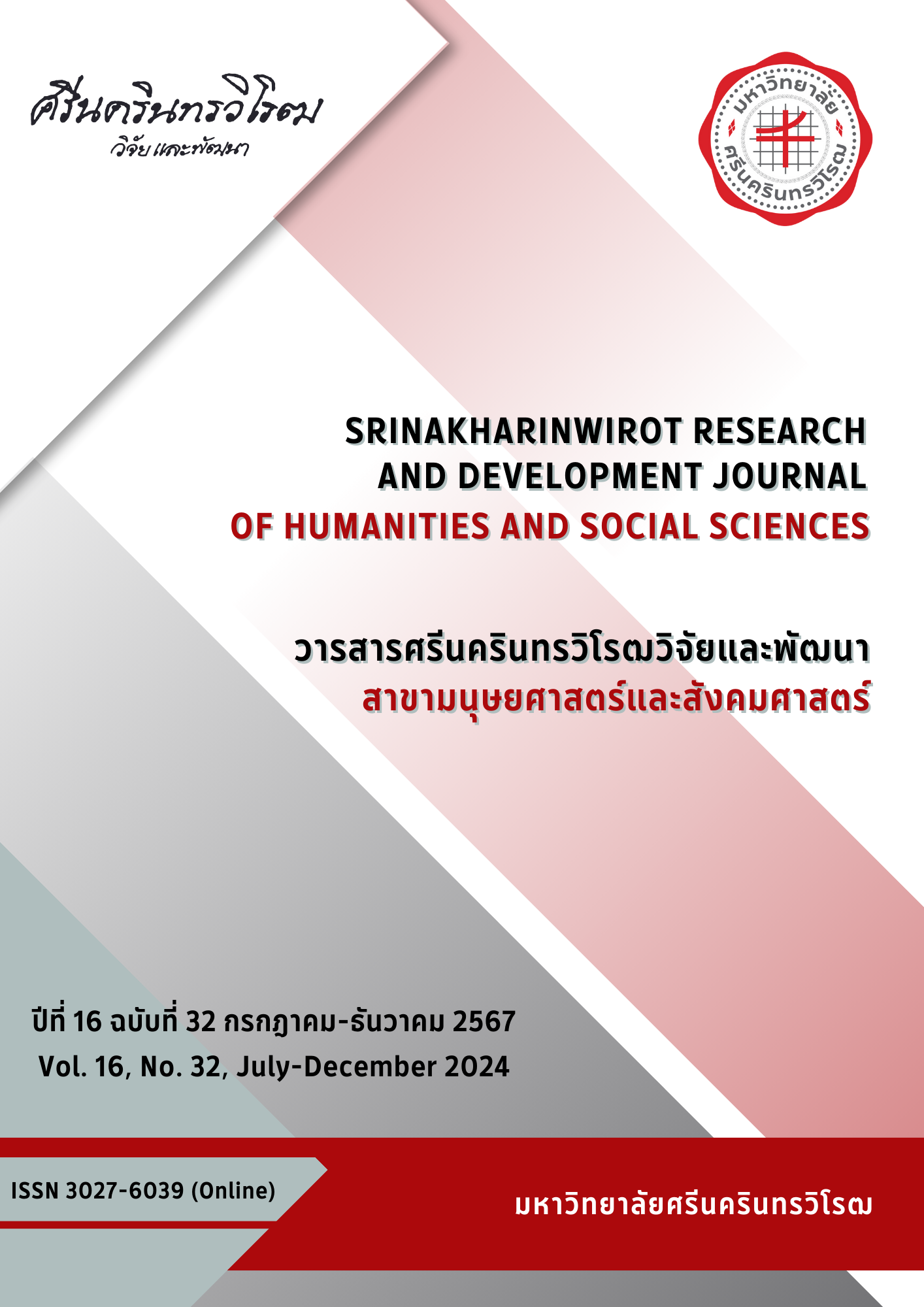INFORMATION PERCEPTION ABOUT THE PREVENTION OF CORONAVIRUS 2019 EPIDEMIC OF PEOPLE IN BANGKOK
Keywords:
Information Perception, Prevent Epidemics, Coronavirus 2019Abstract
This research article was to study information perception and problems about the prevention of the Coronavirus 2019 epidemic of People in Bangkok. The sample was people aged 18 years and over 400 people in Bangkok. No knowledge and experience of the Coronavirus 2019 is required. Using the purposive sampling method with non-probability and Purposive sampling. The instruments for data collection were 5-level rating scale questionnaires. which the validity was between 0.64-1.00 and the reliability was 0.69. and the data were analyzed by frequency, percentage, mean, and standard deviation. The result of the study showed that 1) Most people’s perception of the information on the holiday, use new media such as the Internet, websites, and social media, with the main purpose of up-to-date, content about the prevention of Coronavirus 2019. 2) Perception problems of the receiver is no time to follow up, perception problems of the content of unreliable information, perception problems of the print Media is no printed media to read because they do not subscribe or buy their own, perception problems of the broadcast radio is no radio to listen to. perception problems of the television is broadcast time. perception problems of the personal media is not having enough time / little time to meet, talk, give advice, and perception problems of the new media is false information, and fake news. Suggestions for improving the information perception such as there should be the disclosure of news information and Knowledge like the first round of the epidemic. should have an SMS alert. And should have data verification agency news information published by new media.
Downloads
References
ธานี กล่อมใจ, จรรยา แก้วใจบุญ, และทักษิกา ชัชวรัตน์. (2563). ความรู้และพฤติกรรมของประชาชนเรื่องการป้องกันตนเองจากการติดเชื้อไวรัสโคโรนา สายพันธุ์ใหม่ 2019. วารสารการพยาบาล การสาธารณสุขและการศึกษา, 21(2), 29-39.
World Health Organization. (2022). WHO coronavirus (COVID-19) dashboard. https://covid19.who.int/
Cuffe. R. (2020). Coronavirus death rate: What are the chances of dying?. https://www.bbc.com/news/health-51674743
กรมควบคุมโรค กระทรวงสาธารณสุข. (2565). สถานการณ์ผู้ป่วย COVID-19. https://ddc.moph.go.th/covid19-dashboard/
Bao, H., Cao, B., Xiong, Y., and Tang, W. (2020). Digital media's role in the COVID-19 pandemic. JMIR mHealth and uHealth, 8(9), e20156. https://doi.org/10.2196/20156
สาโรจน์ นาคจู. (2564). พฤติกรรมการป้องกันตนเองจากการติดเชื้อไวรัสโคโรนา 2019 (COVID-19) ของประชาชนในกรุงเทพมหานคร. วารสารวิชาการสถาบันวิทยาการจัดการแห่งแปซิฟิค สาขามนุษยศาสตร์และสังคมศาสตร์, 7(3), 151-160.
จารุวรรณ กิตตินราภรณ์. (2564). การใช้สื่อกับการปรับเปลี่ยนพฤติกรรมปกติใหม่ด้านสุขภาพในช่วงการระบาดของไวรัสโคโรน่า (Covid-19) : กรณีศึกษา จังหวัดปทุมธานี. วารสารนิเทศศาสตรปริทัศน์, 25(1), 15-34.
กวินลดา ธีระพันธ์พงศ์, และจุฑาทิพย์ นามม่อง. (2564). ปัจจัยที่มีความสัมพันธ์ต่อพฤติกรรมการป้องกันการติดเชื้อไวรัสโคโรนา 2019 (โควิด-19) ของพนักงานในโรงงานขนาดใหญ่แห่งหนึ่ง อำเภอกระทุ่มแบน จังหวัดสมุทรสาคร. วารสารพยาบาลศาสตร์ มหาวิทยาลัยสยาม, 22(23), 10-20.
ปทุมมา ลิ้มศรีงาม, ศรัณย์ธร ศศิธนากรแก้ว, และวราพรรณ อภิศภะโชค. (2564). การรับรู้ข้อมูลข่าวสารเกี่ยวกับเชื้อไวรัสโคโรนา 2019 (โควิด-19) ผ่านสื่อสังคมออนไลน์กับทัศนคติและพฤติกรรมการป้องกันโรคในกรุงเทพมหานคร. วารสารมหาจุฬานาครทรรศน์, 8(9), 18-33.
สำนักงานสถิติแห่งชาติ. (2564). สถิติประชากรศาสตร์ ประชากรและเคหะ. http://statbbi.nso.go.th/staticreport/page/sector/th/01.aspx
Goggin, M. K. (1982). Meeting personal needs. In Information Needs of the 80s. Libraries and Information Services Role in “Bring Information to People” Base on the Deliberation of the White House Conference on Libraries and Information Services. London : JAI Press.
Devadason, F. J., and Lingam, P. P. (1997). A methodology for the Identification of information need of uses. IFLA journal, 23(1). https://doi.org/10.1177/034003529702300109
Cronin, J. J., and Taylor, S. A. (1994). SERVPERF Versus SERVQUAL: Reconciling performance - based and perceptions - minus - expectations measurements of service quality. Journal of Marketing, 58(1), 125-131.
Wilson. (1981). On user studies and information needs. Journal of Documentation, 37(1), 3-15.
พรรษา รอดอาตม์. (2561). เนื้อหารายการในโทรทัศน์ดิจิตอลที่ถูกเลือกรับชมภายใต้บริบทที่สื่อมีการผลัดเปลี่ยนแพลตฟอร์ม (Platform), วารสารศาสตร์, 11(2), 300-301.
Lin, N., and Garvey, D. W. (1972). Information needs and uses. In Annual Review of Information Science and Technology. Washington, D.C.: American Society for Information Science.
สิทธิพร เขาอุ่น, รวงทอง ถาพันธ์, และนันทิกา บุญอาจ. (2565). พฤติกรรมการรับรู้ข้อมูลข่าวสาร การมีส่วนร่วม และความรับผิดชอบต่อสังคมในการป้องกันโรคโควิด-19 ของประชาชน ในอำเภอเมือง จังหวัดนครสวรรค์. วารสารวิจยวิชาการ, 5(4), 147-158.
Kippax, S., and Murray, J. P. (1980). Using the mass need gratification and perceived utility. Communication Research.
McCombs, M. E., and Becker, L. B. (1979). Using mass communication theory. Englewood cliffs: N.J. Prentice Hall.
Krikelas, J. (1983). Information seeking behavior: Patterns and concepts. Drexel Library Quarterly, 19, 5-20.
พรพรรณ ประจักษ์เนตร, และกิรติ คเชนทวา. (2565). การจัดการตนเองของบุคคลที่เป็นโรคไม่ติดต่อเรื้อรังในช่วงโควิด-19 และบทบาทของการรู้เท่าทันสื่อสุขภาพแบบออนไลน์ การรับรู้ความสามารถตนเอง การสนับสนุนจากสังคม การรับรู้ความเสี่ยง และพฤติกรรมการค้นหาข้อมูลข่าวสาร. วารสารพัฒนาบริหารศาสตร์, 62(2), 1-35.
ภาวนา พุ่มไสว, สถาพร ขุนเพชร, ปรีชา ชัยกูล, และอารีย์ เต๊ะหละ. (2560). การใช้สารสนเทศบนเครือข่ายอินเทอร์เน็ตของนักศึกษาปริญญาตรี. วารสารอัล-ฮิกมะฮฺ มหาวิทยาลัยฟาฏอนี, 7(13), 81-96.
สำนักงานสถิติแห่งชาติ. (2564). สรุปผลที่สำคัญการสำรวจภาวะเศรษฐกิจและสังคมของครัวเรือน พ.ศ. 2564. กรุงเทพฯ. กองสถิติพยากรณ์ สำนักงานสถิติแห่งชาติ.
วิรุฬ รัตนปริคณน์, และฐิติ วิทยสรณะ. (2562). พฤติกรรมการเปิดรับรายการข่าวและปัจจัยที่มีผลต่อการเลือกเปิดรับรายการข่าว สถานีโทรทัศน์ TNN24 ของประชาชนในเขตกรุงเทพมหานคร. วารสารนิเทศศาสตรปริทัศน์, 23(1), 213-231.
ศศิธร ศรีโพธิ์ทอง, และวิโรจน์ วรรณภิระ. (2565). ความคิดเห็นของบุคลากรทางการแพทย์ต่อการบริหารจัดการด้านบริการของหน่วยบริการปฐมภูมิตามหลักการบริหารจัดทางระบาดวิทยาเพื่อรับมือกับการระบาดของโรคโควิด-19 ระลอกที่ 1 และ 2 ใน จ.พิษณุโลก พ.ศ. 2563. วารสารระบบบริการปฐมภูมิและเวชศาสตร์ครอบครัว, 5(1), 45-58.
ชินีเพ็ญ มะลิสุวรรณ, ย่าร่อนะ ศรีอาหมัด, และรอมซี แตมาสา. (2564). รูปแบบการสื่อสารเพื่อลดความเสี่ยงในการปฏิบัติงานของอาสาสมัครสาธารณสุข ในสถานการณ์การแพร่ระบาดของเชื้อไวรัสโควิด 19 ในพื้นที่จังหวัดยะลา. วารสารสันติศึกษาปริทรรศน์ มจร, 9(7), 2963-2979.
จุฑาทิพย์ จันทร์ลุน. (2563). พฤติกรรมสารสนเทศในยุคโควิด-19. วารสารห้องสมุด, 64(2), 36-49.
Downloads
Published
How to Cite
Issue
Section
License
Copyright (c) 2024 Srinakharinwirot Research and Development Journal of Humanities and Social Sciences

This work is licensed under a Creative Commons Attribution-NonCommercial-NoDerivatives 4.0 International License.
Srinakharinwirot Research and Development Journal of Humanities and Social Sciences is licensed Under a Creative Commons Attribution-NonCommercial-NoDerivs 4.0 International (CC-BY-NC-ND 4.0) License, Unless Otherwise Stated. Please Read Journal Policies Page for More Information on Open Access, Copyright and Permissions.



